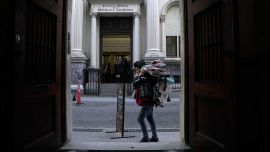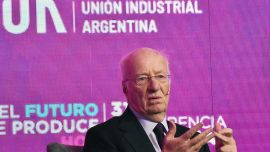Argentina’s Central Bank is struggling to rebuild its chest of foreign reserves as it starts to spend money in currency markets to defend controls propping up the peso, which investors see as overvalued.
Boosting foreign reserves is an essential step for Argentina to eventually lift currency and capital controls, which would encourage more foreign investment and open the way for the nation to return to international debt markets for the first time since its 2020 restructuring.
While President Javier Milei’s government, which controls the Central Bank, quickly started buying dollars in Argentina’s currency market after taking office in December, the pace slowed to a near standstill in June. Monthly purchases topped US$2 billion through May, but the Central Bank had only purchased US$39 million in June as of Thursday.
“Without a change in FX and monetary policy, the Central Bank will be selling in the FX market at least US$3 billion of its international reserves during the third quarter,” Carolina Gialdi, head of international sales at broker Max Valores, said by email.
A spokesman for the Central Bank didn’t respond to a request for comment.
While the Central Bank has still purchased more dollars this month than it has sold, the monetary authority is starting to intervene to prop up the peso, halting the progress made in previous months. On June 19, the Central Bank unloaded US$156 million of foreign reserves, the biggest one-day sale of Milei’s Presidency.
Argentine officials control the official peso exchange rate, which currently stands at about 911 per dollar, and say they plan to maintain a two-percent monthly pace of devaluation known as the "crawling peg," along with other currency measures. Investors see the peg as unsustainable because it’s lagging behind inflation.
Prices in Argentina are up more than 100 percent since Milei took office, but the peso has only depreciated 59% over that period. That means the currency is losing competitiveness and powerful agriculture producers are holding onto their exports until they see the peso devalue at a faster pace.
More signs of pressure are emerging. The parallel peso rate used in financial markets fell to 1,335 pesos per dollar on Wednesday — 32 percent weaker than the official rate, compared to 17 percent last month.
Market volume has fallen to about US$291 million per day in June, down almost 20 percent from the same month last year, according to brokerage ABC Mercado de Cambios. Investors are pricing in a greater chance of devaluation, with three-month peso contracts on the local Rofex futures market rising to 64 percent annualised on Tuesday, from 52 percent in May.
Some investors believe the peso’s plunge may force Milei to act quicker.
“The market is seeing signs that the end of currency controls could be sooner than expected,” Melina Eidner, an economist at Buenos Aires brokerage Portfolio Personal Inversiones, said by phone. “An exit from these controls would necessarily lead to a jump in the exchange rate, due to the level at which the exchange rate gap is.”
Central Bank Governor Santiago Bausili has cut the policy interest rate six times since December, bringing it to 40 percent. That’s so far below 276 percent annual inflation that it discourages Argentines to save in pesos and risks increasing demand for dollars.
Agricultural exporters have sold only a quarter of their soy harvest so far this year, compared to an average of half the crop for the same period last year, according to a person with direct knowledge. There’s still some US$13.5 billion of the harvest to be sold, the person said.
“Lower exports could mean that the FX gap widens,” Gialdi said “The market would feel more comfortable with a central bank that keeps buying reserves as the country doesn’t have market access for now.”
by Ignacio Olivera Doll, Bloomberg





















Comments